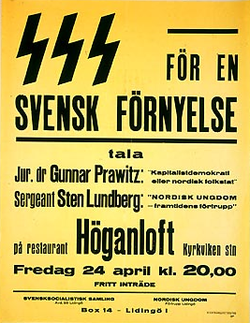"He joined the Swedish National Socialist Freedom League, one of the first Nazi groups in Sweden." (Page 96)

History of Nazis in Sweden after WWll.
The Vangers were involved with Nazi groups and this brings up the question of what were Nazis doing in the Stockholm are after WWll. Nazi hierarchy is a prime example of Structuralism in the way the people were organized by rank and forced to follow the rules of those above them.
"After the war, the Swedish Opposition renamed itself the New Swedish Movement (NSR, Nysvenska Rörelson) and in public attempted to distance itself from Nazi Germany and its own history. In private, it helped smuggle and conceal Nazi collaborators, soldiers, and Waffen-SS volunteers from the refugee camps and allied powers. The regular party activities continued unabated after the war, but the conditions deteriorated. The NSR was refused permission to rent premises in Göteborg including the Hvitfeldtska gymnasiet and the Folkets Hus. Per Engdahl remained a central figure in European National Socialist and fascist circles. The NSR cultivated ties to similar organizations, primarily in Denmark and Norway, and it established an employment office in Malmö for the Danes and Norwegians who collaborated with the wartime occupation forces and fled to Sweden. On May 21, 1951, it hosted 60 delegates for the first "pan-European congress" of Nazis.
The NSR experienced a resurgence during the 1950s. Endahl lectured throughout Europe and made ties with fascists in other countries. The national membership of the party rose successfully. In 1950 a member of the Riksdag,James Dickson of the Rightist Party (now the Moderate Party), took part in a NSR meeting. This success came to a halt in 1960 with the so-called "Swastika epidemic," where the painting of swastikas spread like wildfire in many countries. Rabbi Nussbaum in America argued that the painting of swastikas was led by Per Engdahl from Malmo. Engdahl denied this and claimed the NSR was the victim of a conspiracy by the World Jewish Congress and that it was Jews themselves who were behind the swastikas. From the middle of the 1960s, the NSR membership and contributions dropped, and the party languished (with the exception of a few high-profile events) until the end of the 1980s when it managed to recruit new members. As early as 1991/92 it ceased operation, and the last issue of its magazine Vägen Framålt (The Way Forward) was published in 1992." (http://en.wikipedia.org/wiki/Nazism_in_Sweden)
The Vangers were involved with Nazi groups and this brings up the question of what were Nazis doing in the Stockholm are after WWll. Nazi hierarchy is a prime example of Structuralism in the way the people were organized by rank and forced to follow the rules of those above them.
"After the war, the Swedish Opposition renamed itself the New Swedish Movement (NSR, Nysvenska Rörelson) and in public attempted to distance itself from Nazi Germany and its own history. In private, it helped smuggle and conceal Nazi collaborators, soldiers, and Waffen-SS volunteers from the refugee camps and allied powers. The regular party activities continued unabated after the war, but the conditions deteriorated. The NSR was refused permission to rent premises in Göteborg including the Hvitfeldtska gymnasiet and the Folkets Hus. Per Engdahl remained a central figure in European National Socialist and fascist circles. The NSR cultivated ties to similar organizations, primarily in Denmark and Norway, and it established an employment office in Malmö for the Danes and Norwegians who collaborated with the wartime occupation forces and fled to Sweden. On May 21, 1951, it hosted 60 delegates for the first "pan-European congress" of Nazis.
The NSR experienced a resurgence during the 1950s. Endahl lectured throughout Europe and made ties with fascists in other countries. The national membership of the party rose successfully. In 1950 a member of the Riksdag,James Dickson of the Rightist Party (now the Moderate Party), took part in a NSR meeting. This success came to a halt in 1960 with the so-called "Swastika epidemic," where the painting of swastikas spread like wildfire in many countries. Rabbi Nussbaum in America argued that the painting of swastikas was led by Per Engdahl from Malmo. Engdahl denied this and claimed the NSR was the victim of a conspiracy by the World Jewish Congress and that it was Jews themselves who were behind the swastikas. From the middle of the 1960s, the NSR membership and contributions dropped, and the party languished (with the exception of a few high-profile events) until the end of the 1980s when it managed to recruit new members. As early as 1991/92 it ceased operation, and the last issue of its magazine Vägen Framålt (The Way Forward) was published in 1992." (http://en.wikipedia.org/wiki/Nazism_in_Sweden)